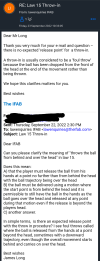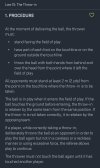
You are using an out of date browser. It may not display this or other websites correctly.
You should upgrade or use an alternative browser.
You should upgrade or use an alternative browser.
Throw Ins
- Thread starter raf83
- Start date
ChasObserverRefDeveloper
Regular Contributor
Needs to be from behind and over in one movement but if doing Mini Soccer read the guidance about giving a second and/or third try, dependent on age of the playersThanks saw this but doesn’t fully explain it to my mind. For example could throw ball in from “behind and over the head” but what if this is achieved in a stunted motion?
**I am humbled later on in the thread, so read on**
Key fouls to look out for:
-If they drop the ball in front of them.
-If they release the ball with their arms out stretched and the ball well past their head.
-If they throw the ball downwards (some quirks around if they adequately duck their head)
-If they jump or throw with one foot in the air.
-If one foot is fully past the white line when they throw it.
I've put the first three in bold as you rarely see or get a chance at the last two points as you'll likely be concentrating on the jostling at the drop zone and there is often no NAR to help you at our level. I wouldn't be having input from a CAR, just muddies the water.
Key fouls to look out for:
-If they drop the ball in front of them.
-If they release the ball with their arms out stretched and the ball well past their head.
-If they throw the ball downwards (some quirks around if they adequately duck their head)
-If they jump or throw with one foot in the air.
-If one foot is fully past the white line when they throw it.
I've put the first three in bold as you rarely see or get a chance at the last two points as you'll likely be concentrating on the jostling at the drop zone and there is often no NAR to help you at our level. I wouldn't be having input from a CAR, just muddies the water.
Last edited:
Gunna need some clarity/expansion on what you mean on these two. Both read like legal throws. May have IFAB receipts to back up. Neither confirm nor deny.Key fouls to look out for:
-If they release the ball with their arms out stretched and the ball well past their head.
-If they throw the ball downwards (some quirks around if they adequately duck their head)
**I am humbled later on in the thread, so read on**
I mean they hold the ball, do the throw motion. Continue to hold onto the ball as it passes from behind their head to in front of their head, and once the ball is in front of their head, in their out stretched arms, they release the ball.

-If they throw the ball downwards (some quirks around if they adequately duck their head)
Similar to the first point but the focus is on them throwing the ball downwards instead of over their head. The quirks I mention is if they bow their head, it can make it legal if they do it right.
-If they release the ball with their arms out stretched and the ball well past their head.Gunna need some clarity/expansion on what you mean on these two. Both read like legal throws. May have IFAB receipts to back up. Neither confirm nor deny.
I mean they hold the ball, do the throw motion. Continue to hold onto the ball as it passes from behind their head to in front of their head, and once the ball is in front of their head, in their out stretched arms, they release the ball.

-If they throw the ball downwards (some quirks around if they adequately duck their head)
Similar to the first point but the focus is on them throwing the ball downwards instead of over their head. The quirks I mention is if they bow their head, it can make it legal if they do it right.
Last edited:
-If they release the ball with their arms out stretched and the ball well past their head.
I mean they hold the ball, do the throw motion. Continue to hold onto the ball as it passes from behind their head to in front of their head, and once the ball is in front of their head, in their out stretched arms, they release the ball.
View attachment 7556
-If they throw the ball downwards (some quirks around if they adequately duck their head)
Similar to the first point but the focus is on them throwing the ball downwards instead of over their head. The quirks I mention is if they bow their head, it can make it legal if they do it right.
As I thought, you appear to be describing legal throws here.
I've asked similar question of IFAB for clarification, see below:

one
RefChat Addict
Have to be careful not to buy into some myths out there. Or even worse helping the myth spread.
A common myth is ball thrown downwards is not lotgful. @JamesL debunked that above. A downward throw may be taken correctly.
Another is if the ball is spinning it's not lotgful. Again that depends how it's done. Just the fact that it's spinning doesn't mean it's a bad throw in.
A throw in does't have to be pretty. It just has to comply with the lotg procedure quoted above. "Ugly but legal" isa phrase I use often.
A common myth is ball thrown downwards is not lotgful. @JamesL debunked that above. A downward throw may be taken correctly.
Another is if the ball is spinning it's not lotgful. Again that depends how it's done. Just the fact that it's spinning doesn't mean it's a bad throw in.
A throw in does't have to be pretty. It just has to comply with the lotg procedure quoted above. "Ugly but legal" isa phrase I use often.
That blows my mind.As I thought, you appear to be describing legal throws here.
I've asked similar question of IFAB for clarification, see below:
View attachment 7557
Kes
I'll Decide ...
I guessed it might when I saw your first post and knew what James was going to come back with.That blows my mind.

We've discussed this at length on here before and whilst every referee seems to have their own opinion on what constitutes a "foul throw", the 3 main requirements of Law 15 are pretty simple.
In my own experience, often the reason the ball travels downwards from a throw is because the thrower hasnt quite started it from behind the head - in which case you can penalise it. But it seems that the myth about the ball having to be released by a certain point in the throwing process still prevails. Your post is a prime example.
In short, just because a throw-in looks naff and/or everybody shouts "foul throw ref" is no reason to penalise it.
If what you've seen is compliant with the 3 components of Law 15 - then play on!!
Here endeth the lesson.

santa sangria
RefChat Addict
If you have NARs it is your job as ref to tell in pre-match or over comms about watching the thrower. With NARs there should never be any doubt about who has the thrower and who has the players.-If they jump or throw with one foot in the air.
-If one foot is fully past the white line when they throw it.
I've put the first three in bold as you rarely see or get a chance at the last two points as you'll likely be concentrating on the jostling at the drop zone and there is often no NAR to help you at our level. I wouldn't be having input from a CAR, just muddies the water.
"Ugly but legal gents. We can't penalise ugly."
Add in any other bon mots you fancy. Normally gets the message across and a giggle too.
Add in any other bon mots you fancy. Normally gets the message across and a giggle too.
socal lurker
RefChat Addict
My two cents. Catching “foul” throws may may be the single least important call in the game. When in doubt, don’t call it. Look for the plat at stuff on long throws.
Aside: once upon a time (decades ago) significant side to side spin on a ball was considered evidence the ball wasn’t really thrown with both hands and was considered improper. But that idea has long, long gone into the dustbin of history. But it occasionally still pops up as a myth.
Aside: once upon a time (decades ago) significant side to side spin on a ball was considered evidence the ball wasn’t really thrown with both hands and was considered improper. But that idea has long, long gone into the dustbin of history. But it occasionally still pops up as a myth.
Especially at OA footballMy two cents. Catching “foul” throws may may be the single least important call in the game. When in doubt, don’t call it. Look for the plat at stuff on long throws.
Aside: once upon a time (decades ago) significant side to side spin on a ball was considered evidence the ball wasn’t really thrown with both hands and was considered improper. But that idea has long, long gone into the dustbin of history. But it occasionally still pops up as a myth.
Catching foul throws at youth football is important for development reasons but once at OA the throw needs to be horrific for it to be worth stopping the game for. You only need to look at the professional game to see that officials aren't bothered with foul throws in the interest of getting the game going


